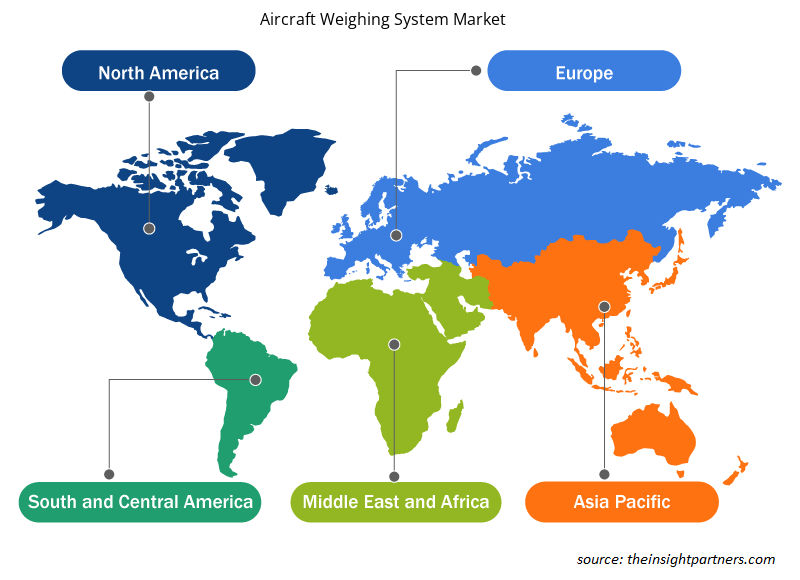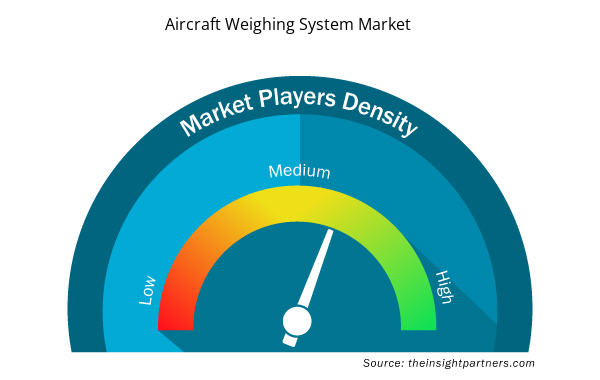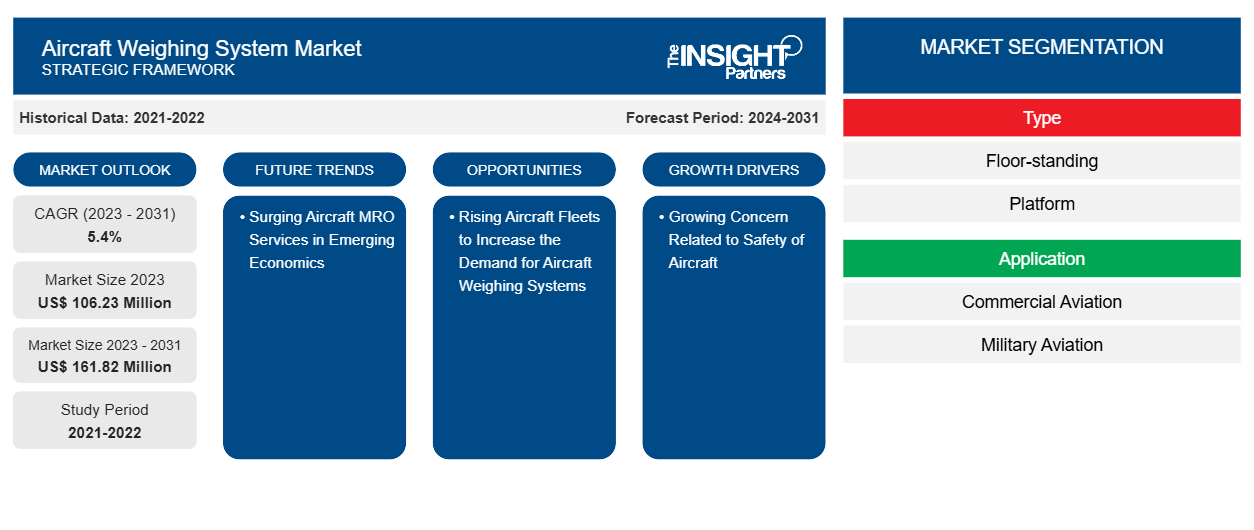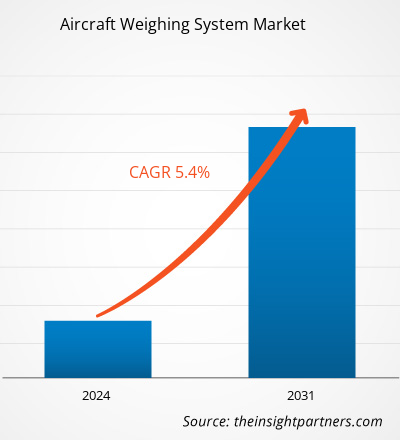Der Markt für Flugzeugwägesysteme soll von 106,23 Millionen US-Dollar im Jahr 2023 auf 161,82 Millionen US-Dollar im Jahr 2031 anwachsen. Der Markt soll zwischen 2023 und 2031 eine durchschnittliche jährliche Wachstumsrate (CAGR) von 5,4 % verzeichnen. Die steigenden MRO-Dienstleistungen für Flugzeuge in Schwellenländern dürften ein wichtiger Trend auf dem Markt bleiben.
Marktanalyse für Flugzeugwägesysteme
Zu den Herstellern von Flugzeugwaagen zählen unter anderem Intercomp, Vishay Precision Group und General Electrodynamics Corp. Die Verfügbarkeit einer großen Anzahl von Komponentenlieferanten ermöglicht es den Herstellern von Flugzeugwaagesystemen, den geeigneten Lieferanten auszuwählen. Dies verbessert die Lieferkette der Komponenten. Nach der Beschaffung von Komponenten produzieren die OEMs von Flugzeugwaagesystemen erhebliche Mengen an Flugzeugwaagesystemen und erfüllen so die jeweiligen Kundenanforderungen. Zu den Endnutzern zählen Flugzeug-OEMs, MRO-Anbieter und Streitkräfte. Flugzeug-OEMs wie Airbus und Boeing, Flugzeug-MROs wie AAR Corporation und Lufthansa Technik sowie Streitkräfte beziehen Flugzeugwaagesysteme von den Herstellern. Mit der wachsenden Produktionsrate von Verkehrs- und Militärflugzeugen wird erwartet, dass die Nachfrage nach Flugzeugwaagesystemen im Prognosezeitraum stetig steigt.
Marktübersicht für Flugzeugwägesysteme
Das Ökosystem des Marktes für Flugzeugwägesysteme umfasst Interessenvertreter wie Komponentenlieferanten, Hersteller von Flugzeugwaagen und Endnutzer. Die Hersteller beziehen kontinuierlich verschiedene Komponenten wie Displays, Sensoren und Pads von den Komponentenlieferanten, um ein Flugzeugwägesystem herzustellen, das den steigenden Anforderungen der Kunden entspricht.
Passen Sie diesen Bericht Ihren Anforderungen an
Sie erhalten kostenlose Anpassungen an jedem Bericht, einschließlich Teilen dieses Berichts oder einer Analyse auf Länderebene, eines Excel-Datenpakets sowie tolle Angebote und Rabatte für Start-ups und Universitäten.
- Holen Sie sich die wichtigsten Markttrends aus diesem Bericht.Dieses KOSTENLOSE Beispiel umfasst eine Datenanalyse von Markttrends bis hin zu Schätzungen und Prognosen.
Treiber und Chancen auf dem Markt für Flugzeugwägesysteme
Wachsende Bedenken hinsichtlich der Sicherheit von Flugzeugen begünstigen den Markt
Das Risiko eines gewichtsbedingten Unfalls bei Frachtflügen ist aufgrund von Fehlern im Ladezettel und falscher Beladung viel höher als bei Passagierflügen. Verschiedene namhafte Akteure auf dem Markt für Flugzeugwaagesysteme sind aktiv an der Entwicklung und Produktion effizienter Waagesysteme für alle Flugzeugtypen beteiligt. Die Beteiligung verschiedener Unternehmen an der Entwicklung eines effizienten Flugzeugwaagesystems und die starke Betonung der Regierungen auf die Vermeidung von Flugzeugunfällen aufgrund verschiedener Faktoren sind die Parameter, die die Nachfrage nach Flugzeugwaagesystemen in allen Regionen antreiben und so die Flugzeugwaagen vorantreiben.
Wachsende Flugzeugflotten steigern die Nachfrage nach Flugzeugwägesystemen
Mehrere Hersteller in allen Regionen konzentrieren sich stark auf die Entwicklung umfassender Lufttransportsysteme der nächsten Generation mit Flexibilität und Kosteneffizienz. Große Flugzeughersteller wie Airbus und Boeing bieten den Marktteilnehmern für Flugzeugwägesysteme enorme Chancen. Die Flugzeuge würden es den Betreibern ermöglichen, neue Langstreckendienste anzubieten, vor allem auf weniger stark befahrenen Routen wie China nach Australien oder Indien nach Europa. Darüber hinaus würden die Eröffnung von Fertigungs-/Montagewerken von Boeing und Airbus in verschiedenen Ländern Asiens und die bevorstehenden einheimischen regionalen Verkehrs- und Regionalflugzeuge wie COMAC C919 und Mitsubishi MRJ den Markt für Flugzeugwägesysteme in den kommenden Jahren weiter ankurbeln.
Segmentierungsanalyse des Marktberichts zum Wägesystem für Flugzeuge
Schlüsselsegmente, die zur Ableitung der Marktanalyse für Flugzeugwägesysteme beigetragen haben, sind Typ und Anwendung.
- Basierend auf dem Typ ist der Markt für Flugzeugwägesysteme in Stand- und Plattformsysteme unterteilt. Das Standsegment hatte im Jahr 2023 einen größeren Marktanteil.
- Basierend auf der Anwendung ist der Markt für Flugzeugwägesysteme in kommerzielle Luftfahrt und Militärluftfahrt unterteilt. Das Segment der kommerziellen Luftfahrt hatte im Jahr 2023 einen größeren Marktanteil.
Marktanteilsanalyse für Flugzeugwägesysteme nach Geografie
Der geografische Umfang des Marktberichts für Flugzeugwägesysteme ist hauptsächlich in fünf Regionen unterteilt: Nordamerika, Asien-Pazifik, Europa, Naher Osten und Afrika sowie Süd- und Mittelamerika.
Der Umfang des Marktberichts für Flugzeugwägesysteme umfasst Nordamerika (USA, Kanada und Mexiko), Europa (Russland, Großbritannien, Frankreich, Deutschland, Italien und den Rest Europas), den asiatisch-pazifischen Raum (Südkorea, Indien, Australien, Japan, China und den Rest des asiatisch-pazifischen Raums), den Nahen Osten und Afrika (Saudi-Arabien, Südafrika, die Vereinigten Arabischen Emirate und den Rest des Nahen Ostens und Afrikas) sowie Süd- und Mittelamerika (Argentinien, Brasilien und den Rest Süd- und Mittelamerikas). In Bezug auf den Umsatz dominierte Nordamerika den Marktanteil von Flugzeugwägesystemen im Jahr 2023. Europa ist der zweitgrößte Beitragszahler zum globalen Markt für Flugzeugwägesysteme, gefolgt vom asiatisch-pazifischen Raum.
Regionale Einblicke in den Markt für Flugzeugwägesysteme
Die regionalen Trends und Faktoren, die den Markt für Flugzeugwägesysteme im Prognosezeitraum beeinflussen, wurden von den Analysten von Insight Partners ausführlich erläutert. In diesem Abschnitt werden auch die Marktsegmente und die Geografie von Flugzeugwägesystemen in Nordamerika, Europa, im asiatisch-pazifischen Raum, im Nahen Osten und Afrika sowie in Süd- und Mittelamerika erörtert.

- Erhalten Sie regionale Daten zum Markt für Flugzeugwägesysteme
Umfang des Marktberichts über Flugzeugwägesysteme
| Berichtsattribut | Details |
|---|---|
| Marktgröße im Jahr 2023 | 106,23 Millionen US-Dollar |
| Marktgröße bis 2031 | 161,82 Millionen US-Dollar |
| Globale CAGR (2023 - 2031) | 5,4 % |
| Historische Daten | 2021-2022 |
| Prognosezeitraum | 2024–2031 |
| Abgedeckte Segmente | Nach Typ
|
| Abgedeckte Regionen und Länder | Nordamerika
|
| Marktführer und wichtige Unternehmensprofile |
|
Marktteilnehmerdichte für Flugzeugwägesysteme: Auswirkungen auf die Geschäftsdynamik verstehen
Der Markt für Flugzeugwägesysteme wächst rasant, angetrieben durch die steigende Nachfrage der Endnutzer aufgrund von Faktoren wie sich entwickelnden Verbraucherpräferenzen, technologischen Fortschritten und einem größeren Bewusstsein für die Vorteile des Produkts. Mit steigender Nachfrage erweitern Unternehmen ihr Angebot, entwickeln Innovationen, um die Bedürfnisse der Verbraucher zu erfüllen, und nutzen neue Trends, was das Marktwachstum weiter ankurbelt.
Die Marktteilnehmerdichte bezieht sich auf die Verteilung der Firmen oder Unternehmen, die in einem bestimmten Markt oder einer bestimmten Branche tätig sind. Sie gibt an, wie viele Wettbewerber (Marktteilnehmer) in einem bestimmten Marktraum im Verhältnis zu seiner Größe oder seinem gesamten Marktwert präsent sind.
Die wichtigsten auf dem Markt für Flugzeugwägesysteme tätigen Unternehmen sind:
- Allgemeine Elektrodynamik Corp.
- Henk Maas Weegschalen BV
- Intercomp-Unternehmen
- Jackson Aircraft Weighing Systems LLC
- Langa Industrial SA
- Vishay Precision Group, Inc.
Haftungsausschluss : Die oben aufgeführten Unternehmen sind nicht in einer bestimmten Reihenfolge aufgeführt.

- Überblick über die wichtigsten Akteure auf dem Markt für Flugzeugwägesysteme
Neuigkeiten und aktuelle Entwicklungen zum Markt für Flugzeugwägesysteme
Der Markt für Flugzeugwägesysteme wird durch die Erhebung qualitativer und quantitativer Daten nach Primär- und Sekundärforschung bewertet, die wichtige Unternehmensveröffentlichungen, Verbandsdaten und Datenbanken umfasst. Nachfolgend sind einige der Entwicklungen auf dem Markt für Flugzeugwägesysteme aufgeführt:
- Intercomp, ein Hersteller tragbarer Produkte zum Wiegen und Messen von Fahrzeugen, hat die Einführung seiner Doppelplattformwaage LTR788 auf dem globalen Markt für Industriewaagen angekündigt. Die LTR788 ist NTEP-zertifiziert für die Gewichtsüberwachung von Nutzfahrzeugen. (Quelle: Intercomp Company, Pressemitteilung, April 2024)
- Intercomp Company erhielt von Airborne Maintenance MRO einen Auftrag zur Bereitstellung eines AC60-LP-Flugzeugwaagensystems. (Quelle: Intercomp Company, Pressemitteilung, August 2020)
Marktbericht zu Wägesystemen für Flugzeuge – Umfang und Ergebnisse
Der Bericht „Marktgröße und Prognose für Flugzeugwägesysteme (2021–2031)“ bietet eine detaillierte Analyse des Marktes, die die folgenden Bereiche abdeckt:
- Marktgröße und Prognose für Flugzeugwägesysteme auf globaler, regionaler und Länderebene für alle wichtigen Marktsegmente, die im Rahmen des Berichts abgedeckt sind
- Markttrends für Flugzeugwägesysteme sowie Marktdynamik wie Treiber, Einschränkungen und wichtige Chancen
- Detaillierte PEST- und SWOT-Analyse
- Marktanalyse für Flugzeugwägesysteme mit Blick auf wichtige Markttrends, globale und regionale Rahmenbedingungen, wichtige Akteure, Vorschriften und aktuelle Marktentwicklungen
- Branchenlandschaft und Wettbewerbsanalyse, einschließlich Marktkonzentration, Heatmap-Analyse, prominenten Akteuren und aktuellen Entwicklungen auf dem Markt für Flugzeugwägesysteme
- Detaillierte Firmenprofile
- Historische Analyse (2 Jahre), Basisjahr, Prognose (7 Jahre) mit CAGR
- PEST- und SWOT-Analyse
- Marktgröße Wert/Volumen – Global, Regional, Land
- Branche und Wettbewerbsumfeld
- Excel-Datensatz



Report Coverage
Revenue forecast, Company Analysis, Industry landscape, Growth factors, and Trends

Segment Covered
This text is related
to segments covered.

Regional Scope
North America, Europe, Asia Pacific, Middle East & Africa, South & Central America

Country Scope
This text is related
to country scope.
Häufig gestellte Fragen
North America dominated the Aircraft Weighing System market in 2023.
The surging aircraft MRO services in emerging economies are the future trend of the aircraft weighing system market.
General Electrodynamics Corp, Intercomp Company, Henk Maas Weegschalen BV, Jackson Aircraft Weighing Systems LLC, Langa Industrial S.A., Vishay Precision Group, Inc., Teknoscale OY, Nicol Scales & Measurement, McCoy Global Inc., HKM Messtechnik are some of the leading players in the market.
US$ 161.82 million estimated value of the aircraft weighing system market by 2031.
5.4% is the expected CAGR of the aircraft weighing system market.
Trends and growth analysis reports related to Aerospace and Defense : READ MORE..
The Insight Partners performs research in 4 major stages: Data Collection & Secondary Research, Primary Research, Data Analysis and Data Triangulation & Final Review.
- Data Collection and Secondary Research:
As a market research and consulting firm operating from a decade, we have published and advised several client across the globe. First step for any study will start with an assessment of currently available data and insights from existing reports. Further, historical and current market information is collected from Investor Presentations, Annual Reports, SEC Filings, etc., and other information related to company’s performance and market positioning are gathered from Paid Databases (Factiva, Hoovers, and Reuters) and various other publications available in public domain.
Several associations trade associates, technical forums, institutes, societies and organization are accessed to gain technical as well as market related insights through their publications such as research papers, blogs and press releases related to the studies are referred to get cues about the market. Further, white papers, journals, magazines, and other news articles published in last 3 years are scrutinized and analyzed to understand the current market trends.
- Primary Research:
The primarily interview analysis comprise of data obtained from industry participants interview and answers to survey questions gathered by in-house primary team.
For primary research, interviews are conducted with industry experts/CEOs/Marketing Managers/VPs/Subject Matter Experts from both demand and supply side to get a 360-degree view of the market. The primary team conducts several interviews based on the complexity of the markets to understand the various market trends and dynamics which makes research more credible and precise.
A typical research interview fulfils the following functions:
- Provides first-hand information on the market size, market trends, growth trends, competitive landscape, and outlook
- Validates and strengthens in-house secondary research findings
- Develops the analysis team’s expertise and market understanding
Primary research involves email interactions and telephone interviews for each market, category, segment, and sub-segment across geographies. The participants who typically take part in such a process include, but are not limited to:
- Industry participants: VPs, business development managers, market intelligence managers and national sales managers
- Outside experts: Valuation experts, research analysts and key opinion leaders specializing in the electronics and semiconductor industry.
Below is the breakup of our primary respondents by company, designation, and region:

Once we receive the confirmation from primary research sources or primary respondents, we finalize the base year market estimation and forecast the data as per the macroeconomic and microeconomic factors assessed during data collection.
- Data Analysis:
Once data is validated through both secondary as well as primary respondents, we finalize the market estimations by hypothesis formulation and factor analysis at regional and country level.
- Macro-Economic Factor Analysis:
We analyse macroeconomic indicators such the gross domestic product (GDP), increase in the demand for goods and services across industries, technological advancement, regional economic growth, governmental policies, the influence of COVID-19, PEST analysis, and other aspects. This analysis aids in setting benchmarks for various nations/regions and approximating market splits. Additionally, the general trend of the aforementioned components aid in determining the market's development possibilities.
- Country Level Data:
Various factors that are especially aligned to the country are taken into account to determine the market size for a certain area and country, including the presence of vendors, such as headquarters and offices, the country's GDP, demand patterns, and industry growth. To comprehend the market dynamics for the nation, a number of growth variables, inhibitors, application areas, and current market trends are researched. The aforementioned elements aid in determining the country's overall market's growth potential.
- Company Profile:
The “Table of Contents” is formulated by listing and analyzing more than 25 - 30 companies operating in the market ecosystem across geographies. However, we profile only 10 companies as a standard practice in our syndicate reports. These 10 companies comprise leading, emerging, and regional players. Nonetheless, our analysis is not restricted to the 10 listed companies, we also analyze other companies present in the market to develop a holistic view and understand the prevailing trends. The “Company Profiles” section in the report covers key facts, business description, products & services, financial information, SWOT analysis, and key developments. The financial information presented is extracted from the annual reports and official documents of the publicly listed companies. Upon collecting the information for the sections of respective companies, we verify them via various primary sources and then compile the data in respective company profiles. The company level information helps us in deriving the base number as well as in forecasting the market size.
- Developing Base Number:
Aggregation of sales statistics (2020-2022) and macro-economic factor, and other secondary and primary research insights are utilized to arrive at base number and related market shares for 2022. The data gaps are identified in this step and relevant market data is analyzed, collected from paid primary interviews or databases. On finalizing the base year market size, forecasts are developed on the basis of macro-economic, industry and market growth factors and company level analysis.
- Data Triangulation and Final Review:
The market findings and base year market size calculations are validated from supply as well as demand side. Demand side validations are based on macro-economic factor analysis and benchmarks for respective regions and countries. In case of supply side validations, revenues of major companies are estimated (in case not available) based on industry benchmark, approximate number of employees, product portfolio, and primary interviews revenues are gathered. Further revenue from target product/service segment is assessed to avoid overshooting of market statistics. In case of heavy deviations between supply and demand side values, all thes steps are repeated to achieve synchronization.
We follow an iterative model, wherein we share our research findings with Subject Matter Experts (SME’s) and Key Opinion Leaders (KOLs) until consensus view of the market is not formulated – this model negates any drastic deviation in the opinions of experts. Only validated and universally acceptable research findings are quoted in our reports.
We have important check points that we use to validate our research findings – which we call – data triangulation, where we validate the information, we generate from secondary sources with primary interviews and then we re-validate with our internal data bases and Subject matter experts. This comprehensive model enables us to deliver high quality, reliable data in shortest possible time.


 Holen Sie sich ein kostenloses Muster für diesen Bericht
Holen Sie sich ein kostenloses Muster für diesen Bericht